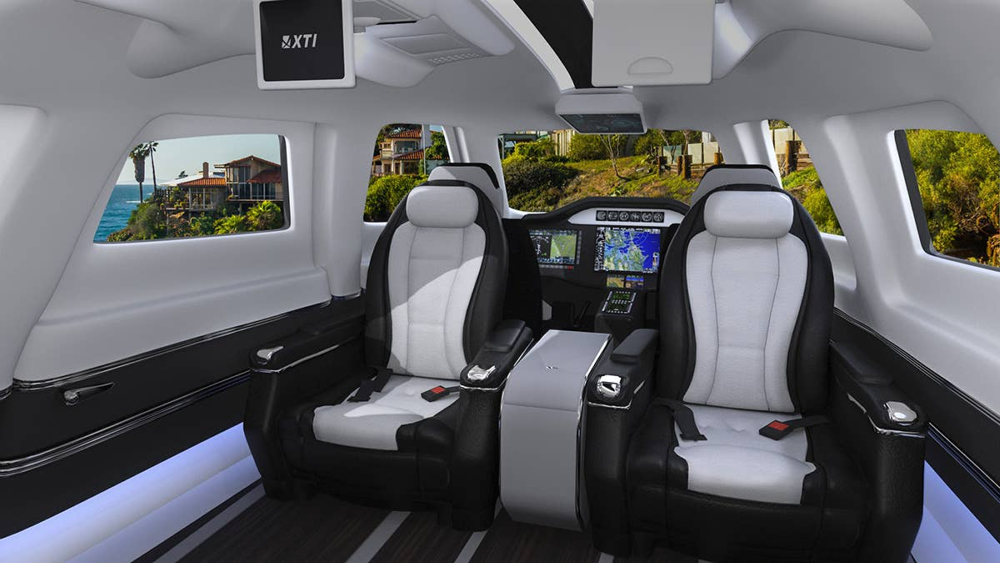XTI Aerospace has steadily drawn interest from the aviation community through its efforts to bring a new era of vertical takeoff and landing to business and regional travel. In a key milestone, the Federal Aviation Administration (FAA) has formally accepted XTI’s application for type certification of its TriFan 600 aircraft. This acceptance signals that the path toward commercial approval is underway.
XTI Aerospace was founded to create more versatile short- to mid-range travel options. Headquartered in Englewood, Colorado, the leadership team at XTI consists of aviation experts and entrepreneurs who identified a market demand for a fast, comfortable, and efficient aircraft that can take off and land vertically. Over the past several years, XTI has honed its design concepts, seeking to bring together the practicality of a helicopter’s vertical lift with the speed and range of a fixed-wing airplane.
XTI’s TriFan 600: Expanding the Role of VTOL in Regional and Specialized Aviation
XTI Aircraft is carving out a distinct path in the evolving vertical flight space with its TriFan 600, a hybrid-electric VTOL aircraft designed to bridge the gap between traditional business jets and the emerging eVTOL category. The TriFan 600 aims to offer fast, flexible, point-to-point travel by integrating advanced propulsion technologies with efficient fixed-wing aerodynamics. Its mission profile extends beyond urban mobility, positioning it as a solution for longer-range and time-critical operations.
Unlike most eVTOL developers concentrating on short-range urban air taxi services, XTI targets underserved sectors. These include regional air mobility, connecting cities within a 500-mile range using existing helipads and airports; air ambulance missions that demand rapid, ICU-level patient transfers between medical facilities; and executive transport, where a 45-minute flight between downtown New York and Washington, D.C., becomes feasible without the delays of commercial air travel.
TriFan 600 Technical Specifications
The TriFan 600 introduces a new Vertical Lift Crossover Airplane (VLCA) category with hybrid capabilities. Key differentiators include ducted fan technology for noise reduction and a fly-by-wire control system enabling both vertical and short runway operations. The phased sustainability roadmap begins with 80% CO₂ reduction through sustainable aviation fuels, progressing toward hybrid-electric and eventual zero-emission configurations.
Design Vision and Propulsion:
XTI has pursued a hybrid-electric architecture for the TriFan 600, aiming to combine the reliability of a turbine power source with electric motors that drive the fans. During vertical takeoff, all three ducted fans produce upward thrust. Once airborne, the wing fans tilt forward, transitioning the aircraft into fixed-wing flight, while the rear fan is shut down and covered to reduce drag.
Passenger Experience and Interior:
The aircraft is planned to accommodate a pilot and up to five passengers for a total capacity of six seats. In concept renderings, the cabin is designed to be pressurized and outfitted with comfortable seating and modern avionics, targeting business aviation customers. XTI intends for travelers to board at a local vertiport or helipad, lift off vertically, and then fly as fast as a typical business aircraft to their destination, reducing overall travel time without sacrificing cabin comfort.

Performance Targets:
• Range: About 650 nautical miles in normal operations, with certain flight profiles expected to extend the aircraft’s range.
• Cruise Speed: Approximately 300 knots, though precise numbers are subject to final design refinements.
• Time to Cruise Altitude: XTI has aimed to allow the TriFan 600 to reach cruising altitude in under 11 minutes.
• Noise Footprint: Ducted fans and electric motors are expected to reduce noise levels compared to traditional rotorcraft, though actual acoustic performance will be evaluated during flight tests.
These figures position the TriFan 600 to compete in the emerging AAM (Advanced Air Mobility) market, emphasizing short-range commuter flights and point-to-point business transport that bypasses congested ground infrastructure.
| Parameter | Specification |
|---|---|
| Seating Capacity | 1 pilot + 6 passengers |
| Cruise Speed | 345 mph (555 km/h) |
| Service Ceiling | 25,000 ft |
| VTOL Range | 700 statute miles (helipad-to-helipad) |
| Conventional Range | 850 statute miles (airport-to-airport) |
| Propulsion System | Twin turboshaft engines (100% SAF compatible) |
| Certification Basis | Single-pilot IFR operations |
| Emergency Configurations | Air ambulance/medevac capable |
COMPETING AIRCRAFT
Although the TriFan 600’s hybrid-electric concept sets it apart, it still faces intense competition from various eVTOL and VTOL developers. While many competitors focus on all-electric solutions, others also explore hybrid technologies. Below is a comparative snapshot of some notable aircraft under development:
The TriFan 600 occupies a unique position between conventional eVTOL aircraft and traditional business jets:
| Competitor | Aircraft | Max Speed | Range | Propulsion | Certification Target |
|---|---|---|---|---|---|
| XTI Aerospace | TriFan 600 | 345 mph | 700-850 mi | Turboshaft/SAF | 2026-2027 |
| Lilium | Jet | 175 mph | 155 mi | All-electric | 2026 |
| Joby Aviation | S4 | 200 mph | 150 mi | Electric | 2025 |
| EmbraerX | Eve | 137 mph | 60 mi | Electric | 2026 |
| Textron | Nexus | 180 mph | 100 mi | Hybrid-electric | 2028 |
Unlike battery-dependent competitors, the TriFan’s current turboshaft configuration enables longer ranges while leveraging existing fuel infrastructure. This strategic compromise allows immediate operational viability while developing future propulsion technologies.
While the TriFan 600 is comparable to Joby Aviation’s S4 and Lilium’s Jet in some respects, its hybrid propulsion and longer-range targets place it closer to a traditional business aircraft performance profile. This could be a key selling point for operators who need greater mission flexibility.
Certification Progress and Timeline
The FAA’s acceptance of XTI’s type certificate application means the agency has determined that the TriFan 600 program is sufficiently mature in its technical description to warrant formal evaluation. Type certification is a complex, multi-year process in which an aircraft’s design, manufacturing methods, and flight qualities are thoroughly assessed for compliance with safety standards. Acceptance of the application is the first official step in that certification journey, generally followed by key phases:
- Conceptual and Preliminary Design Review: XTI will collaborate closely with FAA engineers to confirm that critical design assumptions and structural analyses comply with regulations.
• Rigorous Testing: Scale testing and full-scale prototype flights will help validate performance, flutter characteristics, noise levels, and system redundancy.
• Documentation and Operational Criteria: XTI must provide detailed documentation proving airworthiness, including materials and avionics integration.
• Final Approval: Successful demonstration of compliance leads to granting a type certificate, allowing XTI to proceed with full-scale production and delivery to customers.
The acceptance of the March 2025 Type Certification application follows four years of collaborative rulemaking with the FAA’s Innovation Office to establish AC 21-17b standards for powered-lift aircraft.
Critical path milestones include:
- Q1 2025: Completed downwash/outwash studies and certification application submission8
- Q2 2025: Sparrow subscale model flight testing
- 2026: Full-scale prototype first flight
- 2027: Anticipated Type Certification
If XTI meets its technical targets, the TriFan 600’s extended range and faster cruise speed could be a distinctive alternative to purely electric VTOL aircraft, which often face range limitations due to battery capacity. Although the company has not yet announced finalized performance numbers, industry observers suggest that the TriFan 600’s approach is uniquely tailored to the business travel segment, potentially reducing point-to-point travel time by eliminating airport congestion.
MARKET OUTLOOK
Mesa Airlines’ conditional order for 100 units (potential $1B value) demonstrates commercial confidence, with initial deployments targeting high-demand regional routes like New York-Washington and Los Angeles-San Francisco.
As the advanced air mobility market expands, operators will likely choose vehicles based on mission profile. Smaller eVTOLs, such as the Volocopter VoloCity or EHang 216, may be sufficient for ultra-short hops. For longer missions, the TriFan 600 could fill a gap between small eVTOLs and larger business jets, allowing travelers to avoid runways entirely while covering regional distances. The regulatory environment has been evolving to support these new aircraft. However, the FAA maintains a high standard of airworthiness and safety. XTI’s acceptance by the FAA for a type certificate review signals the regulators’ recognition that hybrid-electric VTOL technology is advancing beyond the concept stage.
Looking ahead, XTI’s success will hinge on its ability to navigate the lengthy certification roadmap and meet the technical promises of the TriFan 600. If everything proceeds smoothly, early production units could debut with launch customers seeking to upgrade private or corporate fleets. At the same time, some operators may evaluate the TriFan 600 for charter missions in densely populated areas. The widespread availability of vertiports or rooftop helipads would significantly enhance its utility and market adoption.
If XTI can validate the aircraft’s hybrid-electric powertrain, deliver the projected range and speed, and maintain a suitable noise footprint, the TriFan 600 may become a prominent offering in the evolving advanced air mobility sector. While challenges remain, this progress demonstrates a growing regulatory willingness to consider advanced VTOL designs and the appeal of faster, more flexible air transport options.





